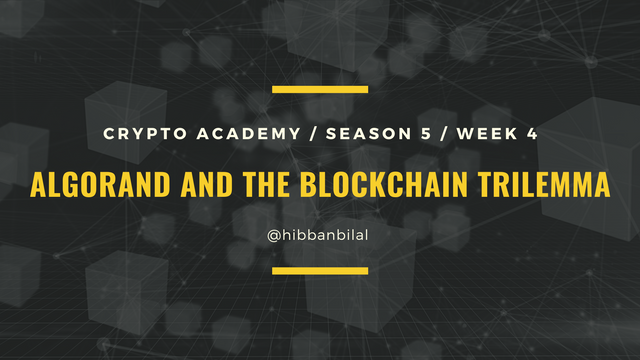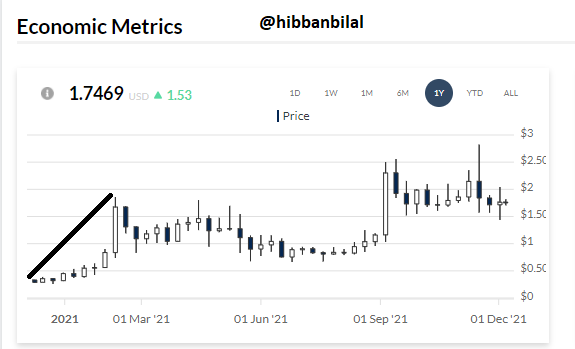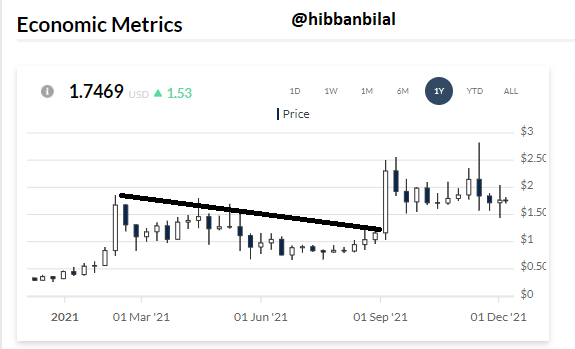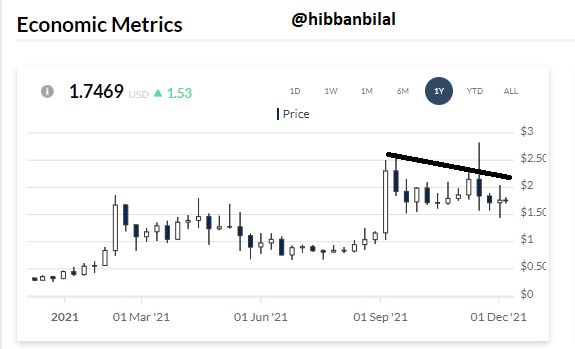Algorand and the blockchain trilemma - Crypto Academy / S5W4 - Homework post for nane15
Hey Steemit!
Here is my homework post for Professor @nane15. It was a great lesson, and I hope you will enjoy reading my post.



Bitcoin may be both thrilling and puzzling, but both are worth exploring. New cryptocurrencies, initiatives, protocols, and networks appear virtually every day, and their prices see dramatic fluctuations to match.
Coin experts have been paying attention to a new project called Algorand and its supporting cryptocurrency Algo. Take a peek at the ALGO market.
As the name suggests, the Algorand blockchain is decentralized and uses the ALGO token as its currency.
Decentralization, transactions without a centralized authority, and tokens that are simple to split are all part of Algorand's vision. Still, it also aims to be faster and use less computational power to function than other well-established cryptocurrencies of the time.
If we talk about market capitalization, which is the total value of all coins or tokens on the network, Algorand is the 34th largest cryptocurrency. The market capitalization was $2.38 billion on July 19, 2021.
Algo's current pricing is around 76 cents per coin. It has been priced as high as $2.16, and its maximum price in 2021 was $1.71. In the past, it has traded for as little as 14 cents a coin.
The ALGO Token's Activists
In 2019, the token Algo was first introduced to the public. Theoretical work began in 2017 under Silvio Micali's guidance at MIT. The project was completed by the end of 2018. Among his many accomplishments, Micali has been awarded the Turing Prize for his work in cryptography and computer science.
Micali was a co-author of the initial Algorand white paper, which envisioned Algorand as more than simply a cryptocurrency; it also envisioned it as a platform for smart contracts and the tracking of property titles and their sale.
Although numerous white papers exist, a cryptocurrency isn't genuine until its tokens are held and transacted, and projects are carried out using them. That was the case in 2019, when a token sale garnered $60 million.
To yet, the Algorand Blockchain's technology has not been tested in the real-world market circumstances of the cryptocurrency industry.
Developers looking to create new decentralized apps may find Algrorand's technological features attractive, making it a good investment in the ALGO coin.
As proof-of-stake blockchains, which minimize the cost of participating in a blockchain's operation, become increasingly popular in the market, Algorand might be included in a cryptocurrency portfolio.


Byzantine consensus is used to build Algorand's PPoS protocol. The amount of influence each user has on selecting a new block is proportional to the number of tokens in the system. Blocks are proposed and voted on by random and secretly chosen users. Proposals and votes may be made by anybody who visits the site. As a user's stake grows, so do their chances of being selected and the weight of their suggestions and votes.
A key feature of Algorand's Proof-of-Stake system is that it relies on the honesty of the whole economy rather than just a select few to ensure that the economy as a whole is secure. Most of the money is safe when it is in good hands. Only a few users may block other users from transacting using alternative ways (described below), where a tiny portion of the economy decides the security of the whole economy. No one in Algorand has enough money to undermine the entire system, and it would be unwise for those who do have money to misbehave since doing so would cause their possessions to lose value.
Decentralization may still be hampered by large stakeholder groups, notwithstanding the success of PoS blockchains in solving scalability difficulties.
The Pure Proof of Stake (PPoS) protocol was developed by MIT professor Silvio Micali to solve the most significant difficulties with PoS networks. Algorand is the company behind the PPoS project.
Most PoS networks have a "rich get richer" dynamic. However, the PPoS protocol suggests an equal distribution of wealth instead. Algorand, established by Micali in 2017, is the first use of the PPoS consensus technique.
As with the PPOs protocol, each token holder's impact is determined by its stake in the system. Users are selected at random, regardless of the stake, via the protocol.
In a dispersed network, it is advantageous for all online users to have the chance to be chosen by the system. The decentralized nature of the blockchain is strengthened, and the system's safety is guaranteed.
Micali came up with the idea of random selection and put it into practice. A famous cryptographer, Algorand's inventor received the Turing Award in 2012 for his contributions to cryptography. Some refer to the Turing award as "the Nobel Prize of computing" since it is the top honor in computer science.


Advantages
- Speed Of Transmission
The Algorand transfer is comparable to that of substantial payment networks thanks to its Consensus Mechanism, which finalizes blocks in seconds. Algorand is the first Blockchain that promises instantaneous transaction completion, so that the possibility of a Hard Fork can be avoided.
To further explain the rapidity, nodes who propose incorrect blocks or engage in the harmful activity are not punished. As soon as a potential problem with the network is discovered, this is done to keep the network running smoothly and prevent any possible dire consequences.
- Participants' Anonymity And Decentralisation At A High Degree
A concern about Proof of Stake was that, although it solved the issue of scalability, it also made it possible for people who staked large numbers of tokens to gain a monopoly, endangering the network's decentralized character.
Purity Proof of Stake seems to handle the problem similarly. Instead of choosing validators based on the number of staked tokens, this algorithm chooses them at random at the beginning. Decentralization and security are both enhanced when all blockchain users may be picked at some time to participate in the validation process.
At the same time, only those recommended may verify whether or not they have been picked, which inhibits assaults and malicious activities. An adversary can only learn who is a stakeholder in the next block's creation once the chosen user is already a participant in the consensus mechanism, therefore deterring attacks.
Disadvantages
While PPOs mitigate against the potential monopoly that a high number of staked tokens may generate, this Consensus Mechanism suffers from the same drawbacks as standard PoS.
The staking incentives aren't great, except as a passive revenue source and connected to huge staked token quantities. They're not particularly enticing.
When a majority of the system's total stake is held by honest users (those who follow the protocol's guidelines), the blockchain can accept any number of dishonest users.
Nodes on Algorand are not penalized for proposing a faulty block since the number of tokens they have staked is not lowered.
An instant recovery mode is activated, and the procedure proceeds. Speed is assured; however, malicious users aren't penalized. Hence the community criticizes this feature for this.

4. Do you think Algorand really solved the blockchain trilemma? Explain your answer.

There has never been anything like it. It has had an influence comparable to that of the Internet. It's important to remember, though, that even a technology this revolutionary isn't without its drawbacks.
The so-called "blockchain trilemma" was one of the most challenging problems to overcome throughout the first decade of the blockchain's existence. The three essential goals of security, scalability, and decentralization couldn't be realized entirely without at least one of them being sacrificed.
There is no compromise in Algorand's solution to the blockchain trilemma. Silvio Micali, MIT professor and Algorand creator, came up with the answer after years of research in cryptography and computer science.
On Lex Fridman's well-known podcast, Micali recently discussed the blockchain trilemma and how Algorand solves it.


PPOS vs. POW
PoW consensus is one of the most flawed protocols in use today since it has deteriorated with time and cannot manage the rising number of users on networks that use it. It is not difficult to learn about blockchain to understand that.
It is impossible to scale this system because it uses a series of nodes that must validate a transaction by solving highly complex mathematical operations; for this, the blocks are processed in an average of 10 minutes, and each time, it is necessary to have more powerful computer equipment capable of solving increasingly complex operations. Once these nodes have agreed on a consensus and verified the following block on their network, this procedure might take some time, especially since the previous block took so long to process the transactions and consequently considerably longer to verify.
Some technologies, such as Bitcoin, can concentrate too much processing power in a small area or even a farm. In 2019, over 75% of the computing power was concentrated in China.
Assuming that at least 51% of the miners join forces, you may launch an assault on the network and alter the blocks processed to defraud the network and its members.
Compared to the PPOS, it's clear that PoW is nowhere near as straightforward. Even though this is a difficult subject, I hope you will do more research to answer any questions you may have.


PPOS VS POS:
The primary issue with PoS is that it is a system that works via the blocking of tokens to participate for the right to process the next block. These tokens cost money. Therefore you must safeguard tickets on the network as evidence of your participation and thus opt for the right to be selected, plainly this in a very proportionate manner to the amount you can block.
Even if there are several ways to block a token, the process takes a predefined amount of time. It may be pretty lengthy (depending on the network), which means that significant corporations can retain most of the tokens issued. These ecosystems are seen as less decentralized and dishonest since participation is difficult and time-consuming.
When to real decentralization in the form of lotteries arranged by the community, PPOS succeeds.


At first, we went to algoexplorer.io. On the home page, we can see multiple Information Like its price, Circulating Supply, Total Supply, Online Stake etc. and much more.

We can also see the Latest Transactions and Latest Blocks there, which is quite good. Everything can be visible to us. In Latest Blocks, we can see the blocks that are being created, and, In the Latest Transactions, we can see the transactions which are being carried out.

When we click on one of the Transactions, we can see the detailed history. For Example, as you see in the screenshot below, we can see Transaction Id, Timestamp, Block, Type.
Under it, we can see the Sender's and Receiver's Addresses and the Amount traded between them.


8. Carry out an analysis of the price of ALGO from the beginning of the year to the present. Via graphics


In the screenshot shown at the right, you can see a clear bullish movement in the price action at the beginning of the year. This brings the price from $0.28 to $1.67 by 9th February.

- The following screenshot shows that the bullish movement in the price is now followed by a bearish movement bringing the price to $1.15 by the end of August.

- The bearish movement came to an end, and a long bullish candle was seen. This candle is followed by an overall bearish movement bringing the price to $1.75 today (7th December).


The Algo is one of the quickest, most secure, and most trustworthy crypto-currencies in circulation today. This will be a very important cryptocurrency when a Borderless Economy becomes a reality.
For one thing, the ALGO coin that Algorand adds into its economy with each new block is given out to everyone who has a particular quantity of ALGO in their wallet.
Smart contracts (programmatic agreements for developing decentralized apps) and tokens, which may represent both new and current assets, are also possible with Algorand.
When it comes to Algorand's economic and financial ecosystems, the Algo is not only a high-performance crypto-currency, but it also performs a variety of other functions. Additional information will be shared soon about how it makes transactions (simple and complex) more secure, how it can be used as a store of value for the Algorand community, and more.
Thanks to Professor @nane15 for sharing this amazing lesson with us.
.jpg)

@steemcurator02
@steemcurator02
@steemcurator02